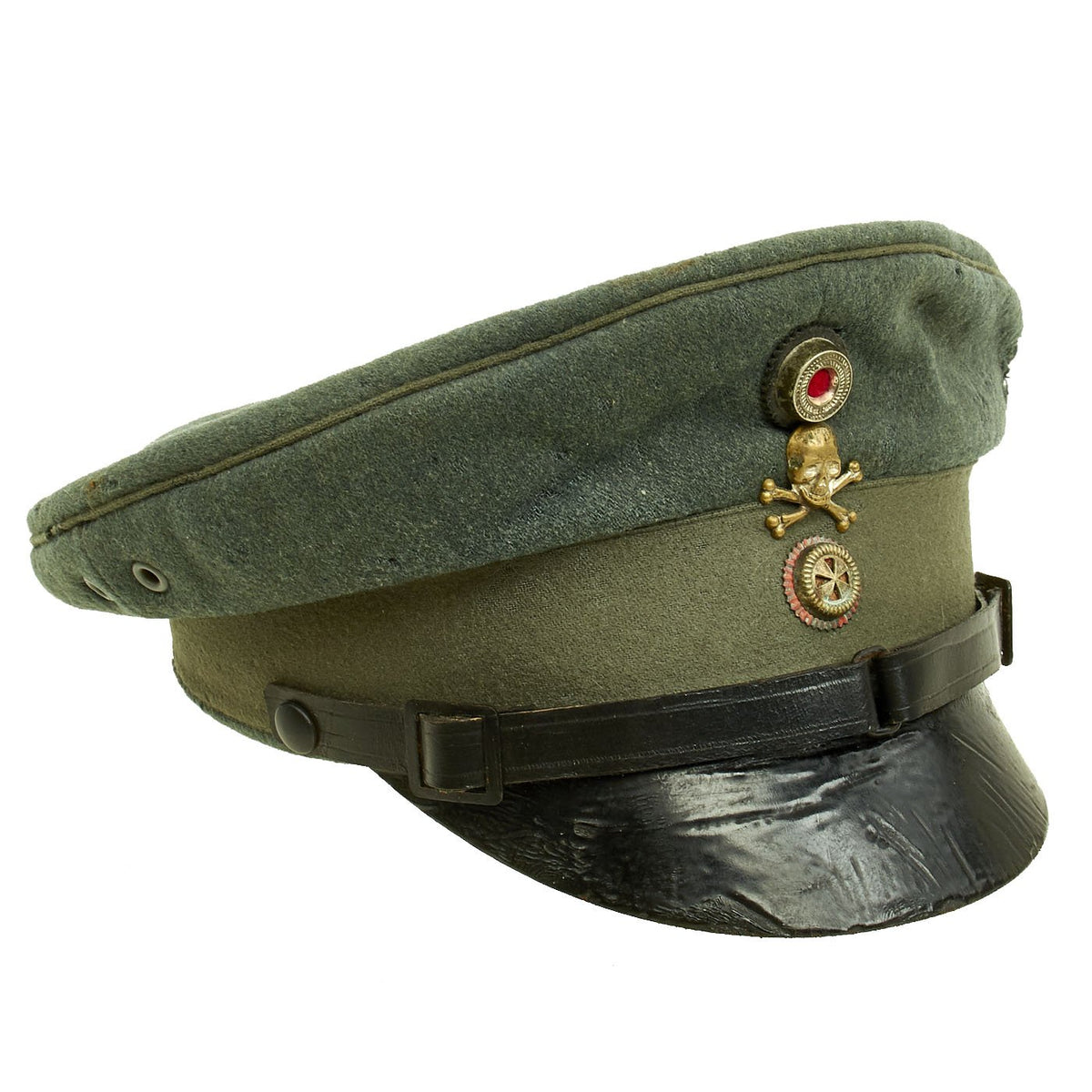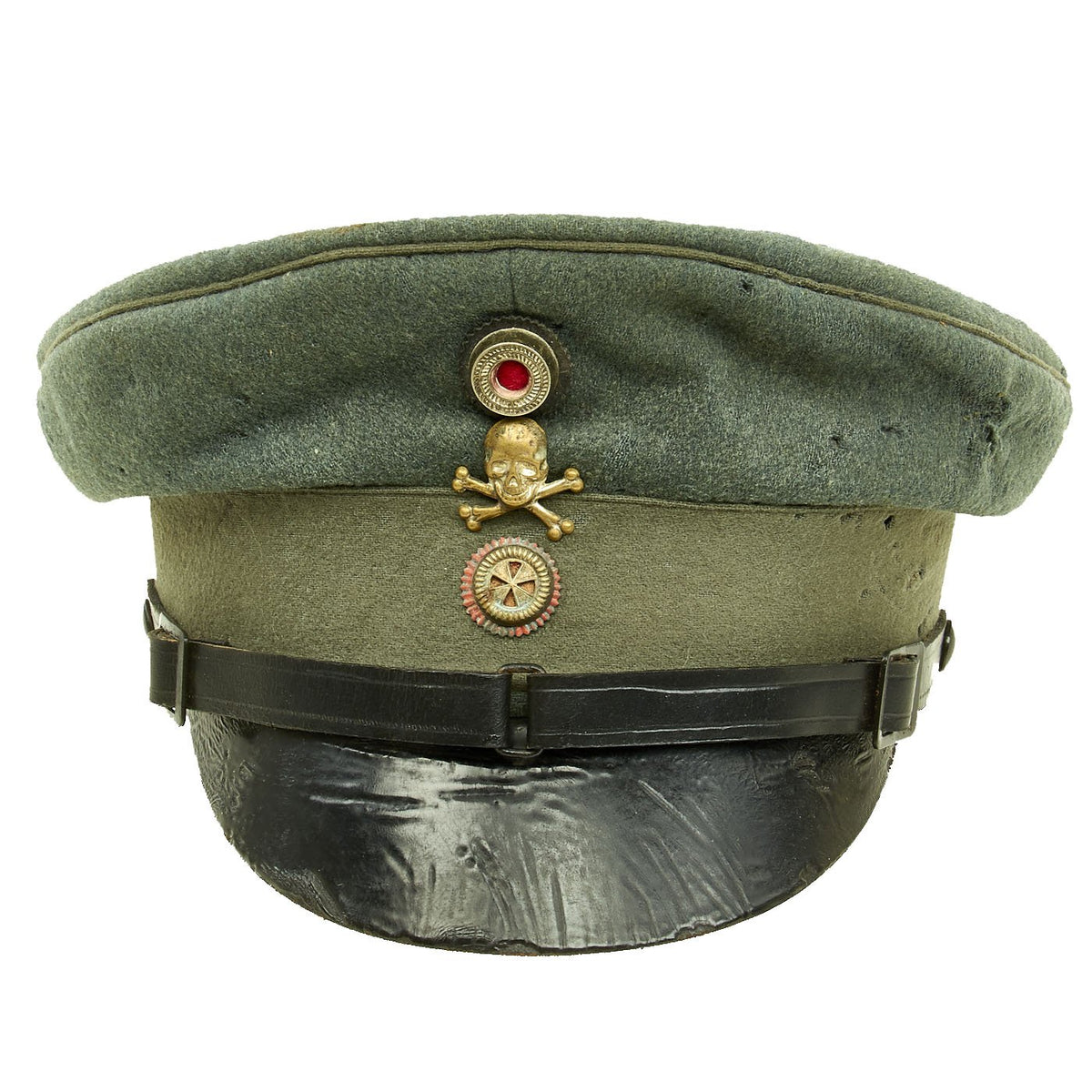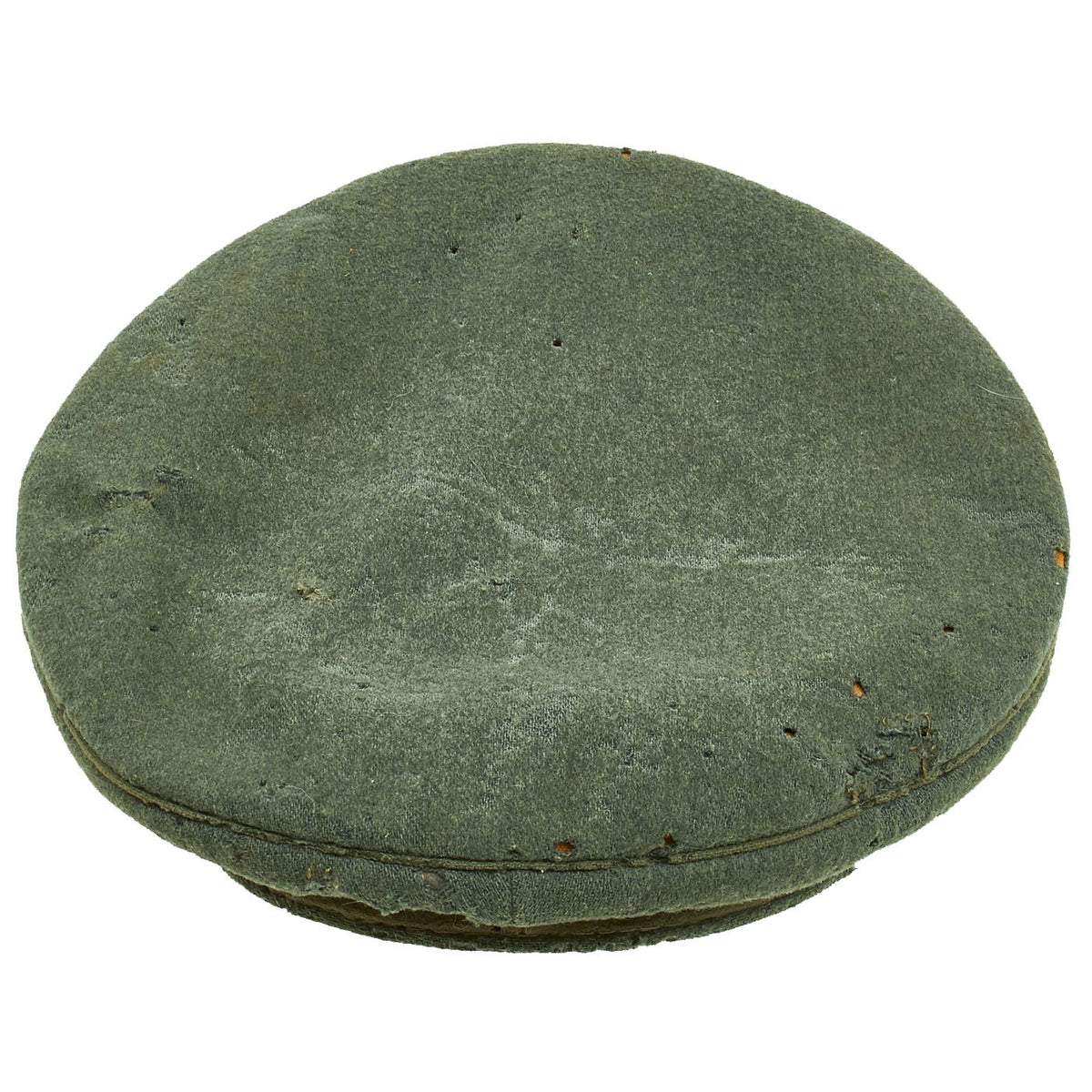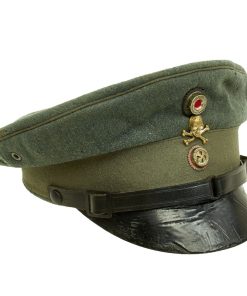Original German Post-WWI Weimar Republic Era Freikorps Visor Cap with Totenkopf Badge – Size 59cm Original Items
$ 995,00 $ 248,75
Original Item: Only One Available. This is a very rare example of a German Post-WWI Issue Freikorps Schirmmütze (Free Corps Visor cap), in very good condition. This example shows high quality fabrication, made with the typical German Army style feldgrau (Field Gray) green / gray wool with an olive green band and a traditional high front. It looks to be for an EM/NCO, but in many cases the Freikorps did not have that level of organization, and members used the caps they had left over from WWI.
The front of the cap has both the Imperial German Tri-Color and Oldenburg cockades attached in the center. Between this is the iconic Freikorps version of the German Totenkopf (Death’s Head) over crossed bones. This emblem had been in use by various elite units since Prussian King Frederick the Great formed the Death’s Head Hussars in the 1740s.
The standard dual-buckled black leather chinstrap, designating the wearer to be an enlisted man, is attached to black lacquered buttons on either side, and is in excellent condition. The leather visor is also in good condition, with a nice shape, though the black finish on the leather has damage from heat and age, which causes it to ripple and crack.
The inside of the cap is lined with light brown “service cloth” type fabric. The top celluloid plastic diamond shield is fully present, with no cracking, and the stitching is fully intact. The maker logo and name is fully visible under the diamond:
(CI Logo)
Stirndruckfreie
Qualitäts-Mütze
D.R.G.M. 1197914
The text under the logo translates to “Forehead Pressure Free Quality Hat”, and D.R.G.M. indicates that it is a registered design, with registration number 1197914. The sweatband of the cap is made of oilcloth, an early leather substitute, and is in good shape, though it is delicate, and has torn through in two areas. There is size label pinned to the inside that reads 59 cm.
The cap is in good shape, though it has suffered wear and moderate moth damage consisting of small holes, tracking, and some repaired areas throughout. The olive green wool center band and crown piping have moderate moth damage as well. The insignia as in good shape, with a lovely patina. Included is a small printout with information regarding the Freikorps during WWII.
A great example of a Rare German Weimar Period Freikorps Visor Cap with all the correct insignia, ready to add to your collection!
The German Freikorps (Free Corps): The meaning of the word Freikorps changed over time. After 1918, the term was used for the paramilitary organizations that sprang up around Germany as soldiers returned in defeat from World War I. They were the key Weimar paramilitary groups active during that time. Many German veterans felt disconnected from civilian life, and joined a Freikorps in search of stability within a military structure. Others, angry at their sudden, apparently inexplicable defeat, joined up in an effort to put down communist uprisings, such as the Spartacist uprising, or exact some form of revenge on those they considered responsible for the armistice. They received considerable support from Minister of Defence Gustav Noske, a member of the Social Democratic Party of Germany. Noske used them to crush the German Revolution of 1918–19 and the Marxist Spartacist League, including arresting and executing leaders Karl Liebknecht and Rosa Luxemburg on 15 January 1919. They were used to defeat the Bavarian Soviet Republic in May 1919.
In 1920, Adolf AH had just begun his political career as the leader of the tiny and as-yet-unknown Deutsche Arbeiterpartei/DAP German Workers’ Party, which was soon renamed the Nationalsozialistische Deutsche Arbeiterpartei/NSDAP (National Socialist German Workers Party) or NSDAP Party in Munich. Numerous future members and leaders of the NSDAP Party had served in the Freikorps, including Ernst Röhm, future head of the Sturmabteilung, or SA, Heinrich Himmler, future head of the Schutzstaffel, or SS, and Rudolf Höß, the future Kommandant of the Ausch prison camp. Hermann Ehrhardt, founder and leader of Marinebrigade Ehrhardt, and his deputy Commander Eberhard Kautter, leaders of the Viking League, refused to help AH and Erich Ludendorff in their 1923 Beer Hall Putsch and conspired against them.
AH eventually viewed some of them as threats. A huge ceremony was arranged on 9 November 1933 in which the Freikorps leaders symbolically presented their old battle flags to AH’s SA and SS. It was a sign of allegiance to their new authority, the NSDAP state.[16] When AH’s internal purge of the party, the Night of the Long Knives, came in 1934, a large number of Freikorps leaders were targeted for killing or arrest, including Ehrhardt and Röhm. Historian Robert GL Waite claims that in AH’s “Röhm Purge” speech to the Reichstag on 13 July 1934, he implied that the Freikorps were one of the groups of “pathological enemies of the state”.
The Weimar Republic (German: Weimarer Republik), officially the German Reich (Deutsches Reich), also referred to as the German People’s State (Deutscher Volksstaat) or simply the German Republic (Deutsche Republik), was the German state from 1918 to 1933. As a term, it is an unofficial historical designation that derives its name from the city of Weimar, where its constitutional assembly first took place. The official name of the republic remained the German Reich as it had been during the German Empire because of the German tradition of substates.
Although commonly translated as “German Empire,” Reich here better translates as “realm” in that the term does not necessarily have monarchical connotations in itself. The Reich was changed from a constitutional monarchy into a republic. In English, the country was usually known simply as Germany, and the Weimar Republic name became mainstream only in the 1930s.
Fast Shipping with Professional Packaging
Thanks to our longstanding association with UPS FedEx DHL, and other major international carriers, we are able to provide a range of shipping options. Our warehouse staff is expertly trained and will wrap your products according to our exact and precise specifications. Prior to shipping, your goods will be thoroughly examined and securely secured. We ship to thousands clients each day across multiple countries. This shows how we're dedicated to be the largest retailer on the internet. Warehouses and distribution centres can be located throughout Europe as well as the USA.
Note: Orders with more than one item will be assigned a processing date depending on the item.
Before shipping before shipping, we'll conduct a thorough inspection of the items you have ordered. Today, the majority of orders will be delivered within 48 hours. The delivery time will be between 3-7 days.
Returns
The stock is dynamic and we cannot completely manage it because multiple stakeholders are involved, including our factory and warehouse. So the actual stock may alter at any time. It's possible that you may not receive your order once the order has been made.
Our policy is valid for a period of 30 days. If you don't receive the product within 30 days, we are not able to issue a refund or an exchange.
You can only return an item if it is unused and in the same state as the day you received it. You must have the item in its original packaging.
Related products
Uncategorized
Uncategorized
Uncategorized
Uncategorized
Uncategorized
Uncategorized
Uncategorized
Armoured Fighting Vehicles of the World: AFVs of World War One (Hardcover Book) New Made Items
Uncategorized
Uncategorized
Uncategorized
Uncategorized
Uncategorized
Band of Brothers ORIGINAL GERMAN WWII Le. F.H. 18 10.5cm ARTILLERY PIECE Original Items
Uncategorized
Angolan Rebel 1970s era 60mm Inert Display Mortar from Angolan Civil War Original Items
Uncategorized
Uncategorized
Uncategorized
Australian WWII Owen MK1 Machine Carbine SMG Custom Fabricated Replica with Sling Original Items
Uncategorized
Uncategorized
Uncategorized
Armored Burgonet Helmet & Polearm from Scottish Castle Leith Hall Circa 1700 Original Items
Uncategorized
Uncategorized












































































